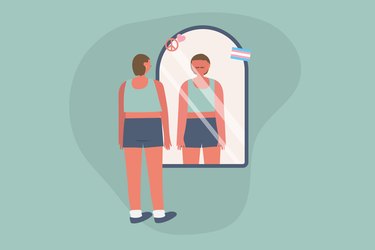
Many transgender and gender non-conforming folks experience gender dysphoria when it comes to having breasts, sometimes called breast or chest dysphoria. And while getting top surgery is one option, it's an expensive and drastic measure that might not be right for everyone.
But there's an alternative: Chest binding is a great way to relieve gender dysphoria without undergoing permanent changes.
Video of the Day
Video of the Day
What Is Chest Binding?
First, a definition: "Chest binding is wrapping athletic binding or wearing a binder garment to flatten the chest," says Kryss Shane, PhD, LSW, who helps transgender people navigate gender dysphoria and other difficult issues in their transition.
Binding reduces the visibility and presence of chest or breast tissue, says Michelle Forcier, MD, MPH, a clinician at FOLX Health who helps many transgender folks navigate their transition. It allows people with large or small chests to get closer to the gender expression that feels best for them. (Chest binding can also be helpful for "persons with larger breasts that interfere with activities," Dr. Forcier says.)
"Chest binding requires that the breast tissue is tightly bound to the torso and chest wall using a variety of materials," Dr. Forcier says. That can include sports bras, binders or small tank tops.
"While binding didn't change how others gendered me, it was one of the few things that alleviated the crushing weight of gender dysphoria I experienced until after my surgery."
Wearing chest binding is a common way to deal with breast dysphoria, or the distress or unhappiness that occurs when a person's gender is mismatched with their sex or gender assigned at birth, says psychotherapist and certified sex therapist Lee Phillips, EdD, LCSW.
"An example of this would be the feeling a trans masculine person might have when he hugs someone and is reminded that his chest is larger than what he feels it should be," Phillips says. "Binding does the opposite of this where the person feels happiness because their gender is being affirmed. An example of this would be a trans masculine person using binding to flatten their breast tissue to create a male-appearing chest," Phillips says.
How Chest Binding Can Address Gender Dysphoria
Before I received my masculinizing top surgery in 2018, I regularly used chest binding to reduce my gender dysphoria. When I first started out, I made the mistake of using Ace bandages because I didn't know any better. (More on what to do — and what not to do — when it comes to chest binding in a moment.)
While binding didn't change how others gendered me, it was one of the few things that alleviated the crushing weight of gender dysphoria I experienced until after my surgery. Once I started transitioning, I was taught about chest binders and got my first binder. My chest was flatter and didn't make me feel like my body was constantly betraying me. I'll never forget the first time I wore my binder.
"Binding can help some persons with gender dysphoria who feel distress because of their chest tissue not being congruent with their gender identity," Dr. Forcier says.
Here's how making your chest flatter may address breast dysphoria, and help you feel more like yourself:
- It makes breasts less noticeable: "Binding can reduce the physical presence of breast tissue under clothing as well as make breasts less visible to others around," Dr. Forcier says.
- It reduces misgendering. "Binding can help reduce someone's chance of being misgendered as female in some spaces," Dr. Forcier says. That is, there's a lower change of being viewed as female and as having breasts.
- It boosts confidence. "Just as many women wear compression garments for a flatter stomach or a push-up bra for a curvier shape, binders simply help the wearer to feel more confident in their appearance," Shane says. By wearing a binder, a person may "feel more comfortable in their body based on how it changes the body's shape under clothing," Shane says.
Potential Side Effects of Binding Your Chest
While chest binding can provide great relief to one's sense of gender dysphoria, it's a temporary solution — people shouldn't wear binders 24/7. Here's what you need to know about potential side effects:
Binding Can Change Breast Tissue
"Binding is completely reversible, but can change or affect breast tissue if done over many years," Dr. Forcier says.
And that can have an effect for people who go from binding to male chest construction. "These changes from binding can impact male chest construction but surgeons can work around these changes, knowing that for many, binding can be lifesaving in reducing dysphoria, as they wait for surgery," Dr. Forcier says.
It Can Affect Breathing
"Binding can cause issues with breathing and moving if it is done too tightly," Phillips says.
Binding Can Be Uncomfortable — and Even Hurt
Using tape as part of the binding can lead to rashes, Phillips says. Plus, it can be painful to remove tape and potentially pull off layers of skin and hair.
Phillips shares this warning: "If the binding hurts, or it cuts the skin, then it is too tight."
Inequity Can Cause Harm
Access to binders isn’t equal for everyone.
People with supportive family or partners, and with financial means, may find it easier to gain access to binders, Shane says.
“Those with support also often have help being wrapped," Shane says. "This is ideal." Using harmful DIY methods — such as duct tape — can lead to the side effects outlined above.
How to Bind Your Chest Safely
These side effects can be easily avoided if you bind safely and regularly take breaks from wearing your binder.
"Binders have been used for many, many years in a variety of settings and for a variety of purposes," Dr. Forcier says. It's a safe, effective strategy to reduce dysphoria for adolescents and adults, Dr. Forcier adds. Plus, binding "is a completely reversible option for both reducing gender dysphoria and exploring gender-affirmative next steps."
Make these practices part of your binding process to help keep you safe and prevent you from long-term damage:
Put Something Between the Binder and Your Skin
"One way to diminish side effects is to apply nonirritating body powder to the skin before binding," Phillips says. Other tips: Wear a thin undershirt as a base layer (before the binder) that's made from sweat-reducing fabric, Phillips says.
Take Breaks
"Use a binder compression shirt made specifically for this purpose, choose a size that fits but is not too tight, and do not wear the binder 24 hours a day, 7 days a week," Dr. Forcier says.
Do not sleep with a binder on, per Fenway Health.
Clean the Binder
"Changing and washing your binder is also helpful and hygienic," Dr. Forcier says. Buildup of sweat and germs can lead to rashes and other skin irritation — not to mention a stinky garment.
Follow the washing instructions on your binder. If you do not have those available, general best practices are to avoid hot water — you can hand wash a binder in the sink with warm water, or wash it in the machine using a delicate cycle, per OUT Maine.
Choose the Right Materials
For instance, Ace bandages are not recommended — not only is this material ineffective compared to more standard binders, but it can lead to local infections, Dr. Forcier says.
"Using a proper binder, i.e., a shirt-like garment made specifically for chest binding, can reduce problems like skin irritation, breakdown, infections," says Dr. Forcier.
Get the Right Size
Getting a properly sized binder is one of the safest ways to bind your chest. "It is important to buy the correct size that compliments physical measurements," Phillips says. A binder that's too small can make it difficult to breathe and cause rib and chest pain, Dr. Forcier points out.
And ease into it: "When someone starts binding for the first time, it is recommended they do it for a few hours each day, so their body gets used to it," Phillips says.
Know the Binder Alternatives
Using a dedicated chest binder isn't the only way to bind safely. Phillips lists other binding methods:
- Layering shirts
- Neoprene waist/abdominal trimmers
- Back support devices
- Athletic compression shirts
Tips for People With Larger Chests
Binding your chest can be difficult if your chest is on the larger side.
“With larger breasts or tissue, binding might be harder, more uncomfortable and not completely diminish or disguise breast tissue,” Dr. Forcier says. “Also, with more tissue to bind, and potentially efforts to more tightly bind, there might be more chances for skin and tissue irritation and breakdown or infection.”
That said, there are binders available specifically for folks with large breasts, Phillips says — you can find them online or at medical supply shops. Phillips also recommends fytist.com.
If you have a larger chest, it can feel disappointing that you can't flatten it as much as you'd like. But it's important to put safety first: People “need to be mindful that they cannot sacrifice breathing or circulation trying to become flatter,” Shane says.
Is this an emergency? If you are experiencing serious medical symptoms, please see the National Library of Medicine’s list of signs you need emergency medical attention or call 911.



